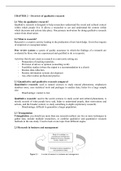CHAPTER 2 – Overview of qualitative research
2.1 Why do qualitative research?
Qualitative research is designed to help researchers understand the social and cultural context
within which people live. It allows a researcher to see and understand the context within
which decisions and actions take place. One primary motivation for doing qualitative research
comes from observation.
2.2 What is research?
Research is a creative activity leading to the production of new knowledge. It involves inquiry
of empirical or conceptual nature.
Peer review system: a system of quality assurance in which the findings of a research are
evaluated by those who are experienced and qualified to do so (experts).
Activities that do not count as research in a university setting are:
- Preparation of teaching materials.
- Provision of advice or opinion (consulting work)
- Feasibility studies (where the output is a recommendation to a client)
- Routine data collection
- Routine information systems development
- Any other routine professional practice.
2.3 Quantitative and qualitative research compared
Quantitative research: used in natural sciences to study natural phenomena, emphasizes
numbers more, uses statistical tools and packages to analyse data, better for a large sample
size.
- Disadvantage: context is lost.
Qualitative research: used in the social sciences to study social and cultural phenomena, is
mostly records of what people have said, helps to understand people, their motivations and
actions, and the broader context, to study something in depth (exploratory research).
- Disadvantage: difficult to generalize a larger population.
2.3 Triangulation
Triangulation: you should use more than one research method, use two or more techniques to
gather data, include multiple researchers, or combine qualitative and quantitative research
methods in the one study. Used to look at one topic from different angles.
2.5 Research in business and management
,2.6 Rigour and relevance in research
A perennial issue for researchers in business and management is the trade-off between rigour
and relevance.
,CHAPTER 3 – Research design
3.1 introduction
Research design: the plan for an entire qualitative research project. This plan should be
written in a research proposal that says what you are going to do. It should provide a road map
of the whole research project, and it should convince your potential supervisors, department,
or advisory committee that you are capable of doing research and that your research project is
viable.
3.2 choosing a topic
Before you start designing a qualitative research project, you should decide upon a topic (in
just a few sentences). Three important requirements in deciding upon a topic: (1) you are
interested in the topic, (2) a faculty member is prepared to supervise you, and (3) you can
obtain relevant qualitative data on the topic.
Once you have decided your topic, it’s time to develop research questions. These questions
should be (1) answerable empirically, (2) relevant to the particular issue that is (or potentially
is) of concern in your chosen field of study, (3) designed to solve a research problem.
In addition, you should cite from top journals in your particular discipline. Examples of this
are on page 23.
Collis & Hussey suggest a useful procedure for starting the process of research design:
3.3 Theoretical framework
After the topic and research questions are identified, the next stage of research design is to
choose a theoretical framework. The key is to find or create a theoretical framework that
matches the research problem that you have designed to investigate. This then drives how the
research project is carried out.
, Theory-building studies is commonly assumed to be more suited to qualitative research.
These studies are more common in the exploratory phase of a new topic or subject area.
However, qualitative research can be used in theory-testing studies when researchers have a
better idea of what to test. An important distinction here, is between deductive and inductive
reasoning.
- Deductive reasoning: researcher starts top-down, so to speak begins with a general
theory about the topic.
- Inductive reasoning: researcher starts bottom-up and begins by collecting data about
the topic (more common for qualitative research). Inductive reasoning is more open-
ended and exploratory, where the main purpose is theory-building. Deductive
reasoning is narrower and more constrained, where the purpose is to test or confirm a
theory.
- Abductive reasoning: emphasises the creative aspect of theory development.
Abduction involves piecing together all the evidence and producing a probable
solution.
3.4 A model of qualitative research design
Every completed qualitative research project consists of the following essential building
blocks or steps. (see figure)
Philosophical assumptions. Every research
project is based on some philosophical
assumptions about the nature of the world and
how knowledge about the world can be
obtained.
Research method. All qualitative researchers
need to decide how they are going to
investigate the social world. Research method
can be defined as a strategy of enquiry. Each
research method build on a set of underlying
philosophical assumption and the choice of
research method influences the way in which
the researcher collects data. Four research methods are: action research, case study research,
ethnography, and grounded theory (chapter 6). It is also important to decide upon the unit
of analysis.
Kwalitatieve onderzoeksstrategieën
Casestudy: per definitie combinatie van verschillende methoden van dataverzameling. Per
definitie gericht op een of enkele gevallen. Kan zowel inductief als deductief.
Etnografische studie: nadruk op participerende observatie, per definitie perspectief van
binnenuit (emic perspective). Kan zowel inductief als deductief. Deel maken van een
organisatie (stage, of als bezoeker).
Actieonderzoek: nadruk op veranderen van de situatie die je onderzoekt, per definitie
perspectief van binnenuit. Alle soorten dataverzameling mogelijk. Kan zowel inductief als
deductief.
Gefundeerde theorie/ grounded theorie: nadruk op interviews, alle soorten dataverzameling
mogelijk. Per definitie inductief (starten met de data, en van daaruit de theorie bouwen). De






